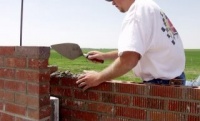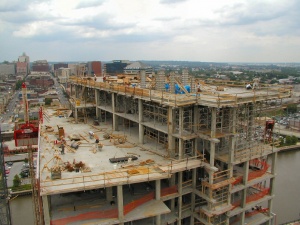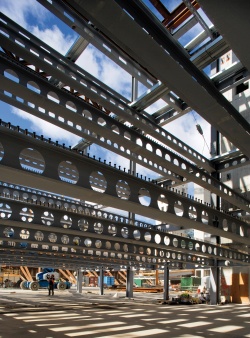End of life LCA and embodied carbon data for common framing materials
The term ‘embodied carbon’ refers to the greenhouse gas emissions (expressed as carbon dioxide equivalents – CO2e ) associated with a product or material during its life cycle. In recent years, the term has become synonymous with the term ‘carbon footprint’. An embodied carbon or carbon footprint assessment is a subset of most Life Cycle Assessment (LCA) studies.
Assumptions about the interpretation of the phrase life cycle can have a significant effect on the results of embodied carbon calculations. Life cycle is sometimes taken to mean manufacture up to and including the point at which the product or material leaves a factory. This is known as ‘cradle to gate’. It can also be taken to mean manufacture plus intermediate processing. An example of this might be steel beam production plus fabrication and erection. It may also incorporate the full life cycle from manufacture, intermediate processing, demolition and all subsequent outcomes (e.g. landfill or recycling); the so-called ‘cradle to cradle’ option.
In the years since environmental considerations have become an important issue in construction and particularly as part of the current drive to tackle climate change, a debate has taken place on the relative merits of the ’cradle to gate’ versus ‘cradle to cradle’ approaches. In the early years, this was won by those who supported a cradle to gate methodology. However, that was mainly due to the fact that relatively little end of life data was available and therefore a robust ‘cradle to cradle’ methodology was generally not possible. But, over time, this has changed and there is now a general acceptance that robust embodied carbon studies are meaningful only when they include ‘cradle to cradle’ impacts, so-called whole life carbon assessments.
This change in emphasis has been accompanied by improvements in the quantity and quality of information available to support the assessments. However, there is still a shortage of high quality end-of-life data for construction products. This article has been prepared to rectify that problem for materials commonly used in building framing systems.
[top]Introduction
This article provides information on the environmental impacts of common construction materials used in building framing systems and covers various types of steel, concrete and brick/blockwork. The information presented for each of the materials is based on work that has been carried out by PE INTERNATIONAL (now sphera), an international market leader in strategic consultancy and software solutions in the field of sustainability.
The data sets are consistent with the modular approach adopted in BS EN 15804[1] and are presented in a format which will be recognisable to anyone who is familiar with Environmental Product Declarations (EPD) prepared according to the Product Category Rules (PCRs) in that standard. PCRs are defined in ISO 14025[2] as a set of specific rules, requirements, and guidelines for developing environmental declarations for one or more products that can fulfill equivalent functions. PCRs determine what information should be gathered and how that information should be evaluated for an environmental declaration.
The data as calculated and collated by PE INTERNATIONAL (now sphera) deals with end-of-life impacts only, i.e. what happens during and after demolition and disposal (the C and D modules in BS EN 15804[1]). This is an area in which, until now, there has been relatively little information available.
The datasets represent average end-of-life conditions for each material used in a building in the UK as at 2012. The reference unit is typically 1kg of material. Users wishing to use this data to make comparisons between different structures and/or different materials should consider the amount of material required for the relevant structural function, as comparing on a per kg basis is misleading.
Information is available on:
- CO2e emissions
- Other environmental impacts (e.g. acidification, eutrophication)
- Parameters describing resource use
- Environmental information describing waste categories
- Environmental information describing output flows
The CO2e emissions information for Modules C and D has been extracted from the data and combined with publically available cradle to gate information (i.e. modules A1 to A3) on CO2e emissions for each of the materials listed under construction product information to produce the first comprehensive summary of whole life embodied CO2e emissions data for common framing materials.
[top]Construction product information
[top]Brick and block
Bricks
The modelled bricks are assumed to have a density of 1922kg/m3. A standard house brick size of 102.5x215x65mm has been assumed with 10mm mortar joints. This gives a brickwork system that is 82.8% brick by volume with 17.2% mortar. Buildings constructed today will generally use cement mortar with brickwork. However, some building projects still use traditional lime or lime/cement mortar. The bricks are assumed to be made from 100% primary material i.e. contain no recycled content.
Concrete blockwork
The modelled blocks are assumed to have a density of 2000kg/m3. A standard block size of 100x215x440mm has been assumed with 10mm mortar joints. This gives a blockwork system that is 93.4% concrete block by volume with 6.6% mortar. The concrete blocks are assumed to be made from Portland Cement and aggregates made up of 100% primary material i.e. with no recycled content.
Module C and D data sheets:
[top]Concrete
Unreinforced concrete
Three grades of unreinforced concrete have been considered; C40, C50 and LC40 all of which are manufactured with CEM I Portland cement. The concrete is assumed to be made from 100% primary material i.e. with no recycled content in either the cement or aggregates. The lightweight concrete (LC40) has a lower density than regular concrete (C40 and C50); for the purposes of this study, a density of 1750 kg/m3 has been assumed, compared to 2400 kg/m3 for regular concrete.
Precast concrete flooring
The modelled product is a hollowcore slab with 263.7 kg/m2 of concrete and 3.2 kg/m2 of reinforcement. The concrete is assumed to be made from Portland cement and aggregates made up of 100% primary material i.e. with no recycled content.
Reinforced concrete
Two grades of reinforced concrete have been considered; RC30 and RC50, each with three variations of cement type; CEM I, CEM II and CEM III (see below). For all options, reinforcement has been assumed to be 2% by volume, equivalent to 156kg/m3 of concrete, and aggregates contain no recycled content.
- CEM I – Portland cement with no recycled content
- CEM II – Portland cement with 30% by mass PFA content
- CEM III – Portland cement with 50% by mass GGBS content
Module C and D data sheets:
- C40 CEM I
- C50 CEM I
- LC40 CEM I
- Precast concrete flooring
- RC30 CEM I
- RC30 CEM II
- RC30 CEM III
- RC50 CEM I
- RC50 CEM II
- RC50 CEM III
[top]Steel
Hot dipped galvanized steel
This dataset represents average end-of-life conditions for galvanised steel strip used in a building in the UK. The reference unit is 1kg of galvanised steel strip. The scrap input into the manufacture of the hot dip galvanised sheets is 0.103kg of scrap/kg of product.
Reinforcing steel
This dataset represents average end-of-life conditions for reinforcing steel used in a building in the UK. The reference unit is 1kg of reinforcing steel. The scrap input into the manufacture of the steel reinforcing bar is 0.698kg of scrap/kg of product.
Steel decking
This dataset represents average end-of-life conditions for steel decking to be used in a composite flooring system in a building in the UK. The reference unit is 1kg of steel decking. The modelled product is made up of hot dip galvanised steel sheets that undergo a cold, roll-forming process to create the decking profile. The scrap input into the manufacture of the hot dip galvanised sheets used to manufacture the steel decking is 0.108kg of scrap/kg of product.
Structural Hollow Sections
This dataset represents average end-of-life conditions for structural hollow sections (SHS) used in a building in the UK. The modelled product is a hot formed structural tube. The reference unit is 1kg of steel tube. The scrap input into the manufacture of steel tubes is 0.121kg of scrap/kg of product.
Module C and D data sheets:
Data for these products can readily be determined as follows.
The Module C data for hot rolled structural steel sections is assumed to be the same as that for structural hollow sections. Module A1-A3 and D data can be found in an article from the BCSA [3]
[top]Whole life embodied CO2e emissions data
| Product | A1-A3 | C1 | C2 | C3 | C4 | D | Total |
|---|---|---|---|---|---|---|---|
| Brickwork1 | 0.16 | 0.0048 | 0.0015 | 0.0021 | 0.0016 | -0.0207 | 0.15 |
| Concrete blockwork2 | 0.09 | 0.0048 | 0.0017 | 0.0024 | 0.0014 | -0.0053 | 0.09 |
| C40 concrete. CEM I. No rebar, recycled aggregates or cement replacement3 | 0.13 | 0.0056 | 0.0017 | 0.0024 | -0.0054 | -0.0053 | 0.13 |
| C50 concrete. CEM I. No rebar, recycled aggregate or cement replacement4 | 0.17 | 0.0056 | 0.0017 | 0.0024 | -0.006 | -0.0053 | 0.17 |
| Lightweight C40 concrete manufactured with CEM I Portland cement5 | 0.17 | 0.0056 | 0.0017 | 0.0024 | 0.0014 | -0.0053 | 0.17 |
| Hollowcore slab with 263.7 kg/m2 of concrete and 3.2 kg/m2 of reinforcement6 | 0.20 | 0.0056 | 0.0022 | 0.0023 | -0.0095 | -0.0103 | 0.19 |
| RC30 concrete. CEM I. 2% rebar, no recycled aggregate or cement replacement7 | 0.20 | 0.0056 | 0.0042 | 0.0022 | -0.004 | -0.0314 | 0.17 |
| RC30 concrete. CEM II. 2% rebar, no recycled aggregate 30% cement replacement (PFA)8 | 0.17 | 0.0056 | 0.0042 | 0.0022 | -0.0046 | -0.0314 | 0.14 |
| RC30 concrete. CEM III. 2% rebar, no recycled aggregate 50% cement replacement (GGBS)9 | 0.17 | 0.0056 | 0.0042 | 0.0022 | -0.0053 | -0.0314 | 0.15 |
| RC50 concrete. CEM I. 2% rebar, no recycled aggregate or cement replacement10 | 0.25 | 0.0056 | 0.0042 | 0.0022 | -0.0057 | -0.0314 | 0.23 |
| RC50 concrete. CEM II. 2% rebar, no recycled aggregate, 30% cement replacement (PFA)11 | 0.20 | 0.0056 | 0.0042 | 0.0022 | -0.0063 | -0.0314 | 0.18 |
| RC50 concrete. CEM III. 2% rebar, no recycled aggregate, 50% cement replacement (GGBS)12 | 0.22 | 0.0056 | 0.0042 | 0.0022 | -0.0074 | -0.0314 | 0.19 |
| Hot dipped galvanised strip steel13 | 2.49 | 0.02 | 0.04 | 0 | 0 | -1.45 | 1.10 |
| Hot rolled structural sections (unfabricated)14 | 1.74 | 0.02 | 0.04 | 0 | 0 | -0.93 | 0.87 |
| Hot formed/finished structural hollow sections13 | 2.49 | 0.02 | 0.04 | 0 | 0 | -1.38 | 1.17 |
| Reinforcing steel15 | 1.27 | 0.019 | 0.042 | 0 | 0 | -0.426 | 0.91 |
| Steel deck16 | 2.52 | 0.02 | 0.04 | 0 | 0 | -1.45 | 1.13 |
Notes:
1A1-A3 data taken from Brick Development Association EPD.
2A1-A3 data assumes averge generic concrete block (taken from concrete centre/Sustainable Concrete Forum fact sheet April 2013) + an allowance for 10% GGBS replacement using physical allocation.
3A1-A3 data calculated assuming cementitious content of 300kg/m3 made up of portland cement, water to hydrate is 25% the cement mass and a normal weight density of 2300 kg/m3. Aggregate makes up the difference in mass. Data for cement/aggregate manufacture and transport to batching plant is taken from Concrete Centre Factsheet 18. No data is included for the batching plant.
4A1-A3 data calculated assuming cementitious content of 400kg/m3 made up of portland cement, water to hydrate of 25% the cement mass and a normal weight density of 2300kg/m3. Aggregate makes up the difference in mass.Data for cement/aggregate manufacture and transport to batching plant is taken from Concrete Centre Factsheet 18. No data is included for the batching plant.
5Lightweight concrete typical specification. A1-A3 data is taken as being typical from Table 1 of Embodied CO2 of structural frames by Kaethner & Burridge, Structural Engineer, May 2012.
6A1-A3 data calculated assuming hollow core slab is C50 grade. C50 CEM I concrete assumes cementitious content of 400kg/m3 made up of portland cement, water to hydrate of 25% the cement mass and a normal weight density of 2300 kg/m3. Aggregate makes up the difference in mass.
Data for cement/aggregate manufacture and transport to batching plant is taken from Concrete centre Factsheet 18. Rebar data is worldsteel global rebar data. Data for precast manufacturing facility is taken from MPA British Precast publication Precast matters 2013.
7A1-A3 data calculated assuming assumes cementitious content of 260kg/m3 made up of portland cement, water to hydrate of 25% the cement mass and a normal weight density of 2300 kg/m3. Aggregate makes up the difference in mass. Data for cement/aggregate manufacture and transport to batching plant is taken from Concrete Centre Factsheet 18. Rebar data is worldsteel global rebar data. 98% of the concrete impact is taken as the remainder is replaced by 2% rebar. No data is included for the batching plant.
8A1-A3 data calculated assuming cementitious content of 260kg/m3 made up of 70% portland cement and 30% fly ash (direct 1:1 replacement), water to hydrate of 25% the cement mass and a normal weight density of 2300 kg/m3. Aggregate makes up the difference in mass.
Data for cement/aggregate/flyash manufacture and transport to batching plant is taken from Concrete Centre Factsheet 18. Rebar data is worldsteel global rebar data. 98% of the concrete impact is taken as the remainder is replaced by 2% rebar. No data is included for the batching plant.
9A1-A3 data calculated assuming cementitious content of 260kg/m3 made up of 50% portland cement and 50% GGBS (direct 1:1 replacement), water to hydrate of 25% the cement mass and a normal weight density of 2300 kg/m3. Aggregate makes up the difference in mass.
Data for cement/aggregate manufacture, GGBS processing, and transport to batching plant is taken from Concrete Centre Factsheet 18. Rebar data is worldsteel global rebar data. The embodied carbon of blast furnace slag manufacture has been calculated by partitioning the blast furnace and underlying physical relationships. More information is available here. 98% of the concrete impact is taken as the remainder is replaced by 2% rebar. No data is included for the batching plant.
10A1-A3 data calculated assuming cementitious content of 400kg/m3 made up of portland cement, water to hydrate of 25% the cement mass and a normal weight density of 2300 kg/m3. Aggregate makes up the difference in mass. Data for cement/aggregate manufacture and transport to batching plant is taken from Concrete Centre Factsheet 18. Rebar data is worldsteel global rebar data. 98% of the concrete impact is taken as the remainder is replaced by 2% rebar. No data is included for the batching plant.
11A1-A3 data calculated assuming cementitious content of 400kg/m3 made up of 70% portland cement and 30% fly ash (direct 1:1 replacement), water to hydrate of 25% the cement mass and a normal weight density of 2300 kg/m3. Aggregate makes up the difference in mass.
Data for cement/aggregate/flyash manufacture and transport to batching plant is taken from Concrete centre Factsheet 18. Rebar data is worldsteel global rebar data. 98% of the concrete impact is taken as the remainder is replaced by 2% rebar. No data is included for the batching plant.
12A1-A3 data calculated assuming cementitious content of 400kg/m3 made up of 50% portland cement and 50% GGBS (direct 1:1 replacement), water to hydrate of 25% the cement mass and a normal weight density of 2300 kg/m3. Aggregate makes up the difference in mass.
Data for cement/aggregate manufacture, GGBS processing, and transport to batching plant is taken from Concrete Centre Factsheet 18. Rebar data is worldsteel global rebar data. The embodied carbon of blast furnace slag manufacture has been calculated by partitioning the blast furnace and underlying physical relationships.More information is available here. No data is included for the batching plant.
13A1-A3 data is worldsteel global average. The global steel industry has invested over many years, in one of the largest and most comprehensive LCA studies ever undertaken. Led by the World Steel Association (worldsteel), the industry has gathered detailed environmental data on steel making from around the world. These data, along with the LCA methodology report, are available from worldsteel or from their member companies. In the UK, data can be obtained directly from Tata Steel.
14A1-A3 and D data from the BCSA[3]. C1-C4 data is assumed to be the same as that for structural hollow sections.
15A1-A3 data is worldsteel global average (excludes any allowance for welding/shaping). The global steel industry has invested over many years, in one of the largest and most comprehensive LCA studies ever undertaken. Led by the World Steel Association (worldsteel), the industry has gathered detailed environmental data on steel making from around the world. These data, along with the LCA methodology report, are available from worldsteel or from their member companies.
16A1-A3 data is worldsteel global average (Hot Dipped Galvanised sheet plus additional emissions from profiling). The global steel industry has invested over many years, in one of the largest and most comprehensive LCA studies ever undertaken. Led by the World Steel Association (worldsteel), the industry has gathered detailed environmental data on steel making from around the world. These data, along with the LCA methodology report, are available from worldsteel or from their member companies. In the UK, data can be obtained directly from Tata Steel.
[top]References
- ↑ 1.0 1.1 BS EN 15804:2012+A2:2019 - Sustainability of construction works - Environmental product declarations - Core rules for the product category of construction products. BSI
- ↑ ISO 14025:2006. Environmental labels and declarations. Type III environmental declarations. Principles and procedures. ISO
- ↑ 3.0 3.1 UK average embodied carbon of structural steel, New Steel Construction, April 2021updated in May 2021
[top]See also
- Sustainability
- Life cycle assessment and embodied carbon
- Steel construction products
- Composite construction







